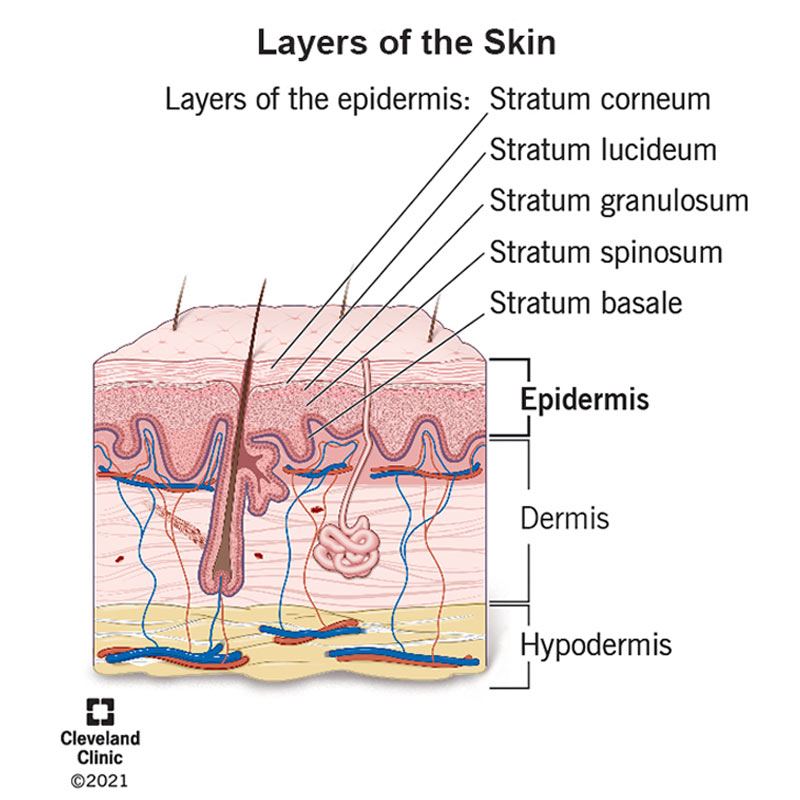Skin care begins with understanding the epidermis
Skin care begins with learning about the skin and getting to know our epidermis
1. How do skin pigmentation and spots occur?
2. Sometimes I feel my skin is greasy and sometimes my skin is dry. What's the matter?
3. After puberty, why do you sometimes have acne on your face?
To know these questions, we need to understand our epidermis.
1. The structure of the epidermis
Keratinocytes in different stages of differentiation constitute the five-layer structure of the epidermis of the skin, which is divided into: stratum corneum, transparent layer, granular layer, spinous layer, and basal layer.
1.1 Stratum corneum
Consists mainly of 10 to 20 layers of flattened, nucleiless dead cells. When these cells are shed, the underlying cells in the basal layer are pushed up to form a new stratum corneum. The main function of the stratum corneum is to protect the underlying tissue from dehydration, bacterial invasion, and resistance to chemical and external stress. The cells of the stratum corneum contain keratin, which helps to reduce water evaporation and even absorb water, keeping the skin moisturized.
1.2 Stratum lucidum
Consisting of 2~3 layers of flat, non-nucleated cells, closely arranged and with unclear interface, it plays the role of controlling moisture, balancing oil, and maintaining acid-base balance. It has almost no distribution on the face and will not be discussed.
1.3 Stratum granulosum
Composed of 2-3 layers of cells, the cells are arranged parallel to the skin surface, the cells are spindle-shaped, the nucleus is oval, and there are obvious transparent keratin particles around the nucleus, which have strong refraction and can filter part of the ultraviolet rays. As the keratinization process of the granular layer cells continues to the surface layer, mucopolysaccharides, phospholipids and other cytoplasms are continuously discharged from the cells and enter the intercellular space to form a part of the intercellular substance, making the bonding between the surface cells stronger.
The granular layer can reduce moisture volatilization and prevent some external substances such as heavy metal ions, polymer compounds, dust, fine particles, etc. from invading the skin.
The above three layers are collectively referred to as the outer layer of the epidermis
1.4 Stratum spinosum
Composed of 4-8 layers of polygonal cells with spinous processes, it is the thickest layer of the epidermis. Lymph fluid flows in the intercellular space to provide nutrients for the cells, and the cells in the deep layer close to the basal layer have the ability to divide and proliferate.
The cells contain polysaccharides, which are hydrophilic and adhesive. It also contains glycoconjugates, estrogen receptors, glucocorticoids, adrenaline and other hormone receptors, HLA-DR antigens, and epidermal growth factor receptors.
The spinous layer acts as a bridge between the basal layer and the outer layer of the epidermis. The new cells produced by the bottom basal layer will divide and proliferate through the spinous layer to reach the three outer layers of the epidermis.
1.5 Stratum basale
The basal layer is located at the bottom of the epidermis. There are two main types of cells: basal blasts and melanoblasts, and a small number of Merkel cells, which are the origin of new cells and pigments. They are the only layer of the epidermis that can effectively divide.
Basal mother cells: The new cells produced are pushed upward continuously, and finally reach the stratum corneum to become new keratinocytes. This process takes 14 days. The new keratinocytes gradually age, die and finally peel off. This process takes about 14 days, plus It takes 19 days to create new cells, a total of 47 days, and a complete cycle of epidermal metabolism.
Melanoblasts: Melanocytes account for about 10% of the basal layer. This proportion is the same whether it is black, yellow or white. It is the base camp for producing melanin. The amount and size of melanin determine the color of the skin. Melanocytes absorb ultraviolet rays in the sun through melanin to protect the dermis and prevent excessive penetration of ultraviolet rays into the body. More melanin will be produced under ultraviolet radiation.
Merkel cells: Connected to nerve endings and have sensory functions. From the basal layer to the granular layer, Langerhans cells are distributed: participate in immunity, eliminate epidermal tumor cells, and prevent the spread of skin virus infections.
2. The function of the epidermis
2.1 Moisture Control and Stay Moisturized
It is necessary to control excessive volatilization in a dry environment, and prevent the intrusion of moisture in a humid environment, so that the entire epidermis moisture content is kept at 15-20%. If it is less than 10%, the skin will be dry, its function will decline, and it will lose its luster.
2.2 Block UV penetration
Partial ultraviolet rays are reflected by the transparent horny particles in the stratum corneum and granular layer, and the melanin distributed throughout the epidermis can absorb ultraviolet rays.
2.3 Prevent foreign object intrusion
The epidermal keratinocytes are tightly arranged, and the gaps are filled with polysaccharides and phospholipids, forming a meticulous "brick and mud structure", which can effectively prevent the invasion of external particles, bacteria, germs, chemical polymers and heavy metal compounds.
2.4 Immune Function
The epidermis contains a variety of immune cell components and immune molecular components, among which Langerhans cells are an important immune cell that can produce specific and nonspecific immune responses to invading foreign substances, eliminate epidermal neoplastic cells and prevent Spread of skin viral infection.
Generally, when women are 25-28 years old, skin metabolism is the most active and reaches the peak in their lifetime; when they are 30-70 years old, the renewal rate of epidermal cells decreases by about 50%, and their ability to repair wounds also weakens.
3. Common Skin Problems
3.1 Dry skin
Reason: In addition to environmental factors, there is a problem with its own mechanism. The keratinocytes divided by basal mother cells are shriveled and dehydrated, which is unhealthy. After being metabolized and reaching the granular layer, a large amount of water will be absorbed, making the skin surface look dry and dehydrated.
Measures: In addition to using moisturizing skin care products, it is also necessary to care for the dermis. The energy and nutrition of the basal layer of the epidermis come from the dermis. When the collagen fibers in the dermis are lost and damaged, and the blood circulation is blocked, the keratinocytes in the basal layer will be unhealthy. The care of the dermis will be discussed in the next section.
3.2 Pigmentation and spots
Cause: Pigmentation and spots are caused by melanin granules produced by melanoblasts in the basal layer and then diffused to other layers. The production and metabolism of melanin are affected by many factors, such as ultraviolet rays, endocrine, cytokines, mental factors, sleep and use Heavy metal cosmetics containing lead and mercury directly affect the aesthetic characteristics of the skin such as color, luster, and fineness. When you see spots on the surface, in fact, a lot of melanin has been hidden and accumulated in the basal layer.
Measures: Don't stay up late, and use sunscreen at all times. Don't use unhealthy skin care products, healthy skin care products are very simple. That is, only use the sunscreen and moisturizing functions of skin care products, and don't expect other functions of skin care products, such as blemishes, wrinkle removal, and skin rejuvenation. Even for very expensive skin care products, except for sun protection and moisturizing, other functions are minimal and can be ignored. It may not be as effective as drinking a glass of ice water or resting for a few minutes. Our whitening and tenderness after using skin care products is due to the feel and touch of the polymers contained in the skin care products themselves, not the changes in the skin itself.
3.3 skin inflammation
All kinds of pimples and acne on the skin are chronic skin inflammation.
Cause: It is mainly related to factors such as excessive sebum secretion of the skin, blockage of the pilosebaceous gland duct, bacterial infection and inflammatory response. When the sebaceous glands secrete too much, the abnormal keratinization of the pilosebaceous ducts will cause the ducts to be blocked, the sebum discharge will be hindered, and acne will form. This situation mostly occurs in adolescence. Microorganisms, especially Propionibacterium acnes, proliferate in large numbers. The lipase produced by Propionibacterium acnes decomposes sebum to generate free fatty acids.
Measures: Do not brush acid easily, so as not to soften the stratum corneum and granular layer, allowing microorganisms to take advantage of them. Do not over cleanse skin. Use ultrasonic cleaning equipment with caution, such as ultrasonic facial cleansers.
3.4 Skin Allergies & Red blood
Allergies and red blood streaks are easy to accompany, let's discuss together.
Reason: The causes of skin allergies and red blood streaks are very complicated. For the epidermis, the unhealthy use of skin care products and cosmetics is a common cause. The "benzoic acid" in skin care products repeatedly stimulates the facial skin, resulting in thinning of the stratum corneum, shallower dermis and capillaries, and heavy metals in cosmetics can cause Toxins remain on the epidermis, causing sensitive reactions and damaging the stratum corneum, all of which can cause skin allergies and red blood. Poor eating habits, spicy food, alcohol and tobacco addiction are also closely related to the onset of telangiectasia, which can easily lead to inflammatory reactions and allergies, and aggravate the damage and expansion of capillaries.
Measures: Similar to dealing with inflammation, first have good living and eating habits, do not over-clean the face, and use skin care products reasonably. The red blood cells can be treated with 805nm LED lights in the early stage, and severe cases need to go to the hospital for treatment.
Thank you for reading here. This article is the most systematic and comprehensive introduction to skin knowledge on the entire network. Skin care starts with learning skin knowledge.


